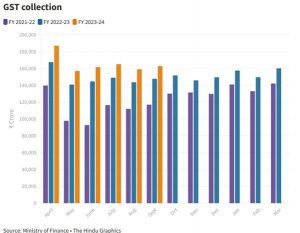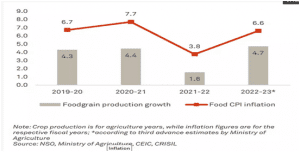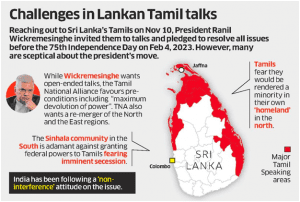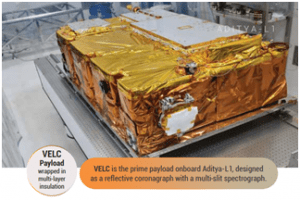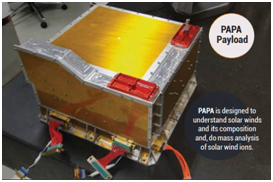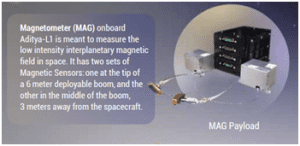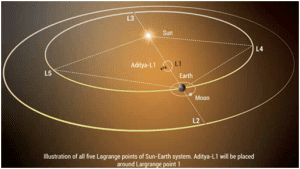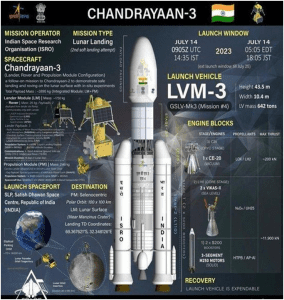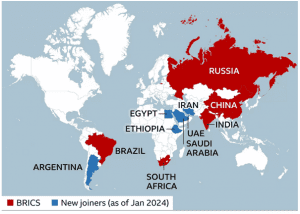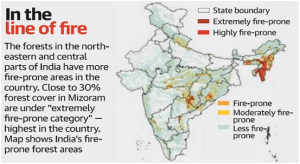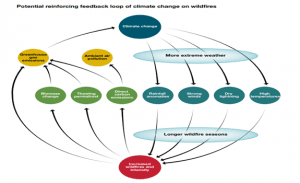THE CONTEXT: Recently, the Centre-State tussle over Open Market Sales Scheme was in the news when the Centre discontinued wheat and rice sales to states via Open Market Sale Scheme (OMSS). Centre is considering it as an effort to control inflationary trends and maintain adequate stock levels under the central pool while states have other views. This article analyses this issue in detail from the UPSC perspective.
HOW HAS THE CENTRE REVISED THE OMSS?
● Recently, the Centre decided to restrict the quantity that a single bidder can purchase in a single bid under the OMSS.
● While the maximum quantity allowed earlier was 3,000 metric tonnes (MT) per bid for a buyer, it will now range from 10-100 metric tonnes (MT).
● As part of the revised policy, the government has decided to exclude state governments from the purview of OMSS (Domestic) following the recommendation of the Inter-Ministerial Committee (IMC) meeting held on 8 June 2023.
● The IMC proposed discontinuing the sale of wheat and rice under OMSS (D) to state governments, except for the North-Eastern states, hilly states and states facing law and order issues or natural calamities.
Objectives of the Move:
● The rationale given for the same is that the quantities have been reduced this time to accommodate more small and marginal buyers and to ensure wider reach of the scheme, and this move will allow the supplies to the general public immediately.
● The objective behind the move is also to curb retail prices, as allowing smaller bids should ideally break the monopolies of bulk buyers, allowing more competitive bids by small buyers.
● It aims to control inflationary trends and to maintain adequate stock levels under a central pool for distribution under the National Food Security Act and other welfare schemes.
Reasons for the Move:
● Due to global supply chain shocks like the Russia-Ukraine conflict hampered production at home, and retail food inflation has risen sharply.
● It aims to maintain adequate buffer stock and control price rise amid concerns that the kharif crop is being impacted due to an expected shortfall in monsoon rains due to El Nino.
● The Centre said that in recent years, production of agricultural crops was affected due to untimely rains, a rise in temperature in the month of March and so on.
● Another reason for the move is to meet the FCI’s food security obligations, as FCI is obliged to release its stocks “judicious manner under the OMSS (D)” so that the overall stock position is maintained at a comfortable level”.
● FCI stated that the Centre was already meeting its obligations to distribute grains to 80 crore marginalised beneficiaries under the NFSA and also had an obligation to the 60 crore common consumers who are affected by retail prices.
EFFECTS OF THIS STEP: (STATE’S RESPONSE)
● Under the OMSS, the FCI sells excess rice and wheat to bulk buyers, traders, and States to moderate market prices and to enhance supply during lean seasons. Over 6,800 thousand metric tonnes of rice were sold through the OMSS in the past eight years. Karnataka bought 30% of it, the highest among all states.
● States have been looking at alternative ways of procuring wheat and rice in the aftermath of the FCI quantity restrictions, followed by the refusal to allow states to procure the two food grains through its OMSS.
● Opposition-ruled States such as Karnataka and Tamil Nadu have criticised the government for engaging in “politics” at the expense of marginalised beneficiaries of state welfare schemes.
● Karnataka: The government in Karnataka announced that being unable to procure enough rice in the market at a reasonable cost in time to meet the needs of the Anna Bhagya scheme, it had decided to temporarily give cash to the beneficiaries in lieu of the promised five kg of free rice.
● Tamil Nadu: The government in Tamil Nadu had also raised concerns about bringing restrictions to the purchase of States from the FCI. The state government has sought alternative sources to purchase 50,000 tonnes of rice. The state used to buy rice through the scheme and then subsidize it for ration card holders.
THE OPEN MARKET SALE SCHEME (OMSS)
● It refers to the selling of foodgrains by Government/Government agencies at predetermined prices in the open market from time to time.
● It enhances the supply of grains, especially during the lean season, to moderate the general open market prices, especially in the deficit regions.
● For transparency in operations, the Corporation has switched over to e-auction for sale under Open Market Sale Scheme (Domestic).
● The FCI conducts a weekly auction to conduct this scheme in the open market using the platform of commodity exchange NCDEX (National Commodity and Derivatives Exchange Limited).
● The State Governments/ Union Territory Administrations are also allowed to participate in the e-auction if they require wheat and rice outside Targeted Public Distribution System (TPDS) and Other Welfare Schemes (OWS)
● The present form of OMSS comprises 3 schemes as under:
(i) Sale of wheat to bulk consumers/private traders through e-auction.
(ii) Sale of wheat to bulk consumers/private traders through e-auction by dedicated movement.
(iii) Sale of Raw Rice Grade ‘A’ to bulk consumers/private traders through e-auction.
How does the Scheme work?
● Firstly, the procurement of food grains like wheat and paddy for the central pool happens in Rabi and Kharif marketing seasons by the FCI and State corporations.
● It happens according to procurement estimates finalized by the government of India before the seasons. These purchases happen as per the Minimum Support Price.
● From the central pool, the government has to set aside wheat and rice for the 80 crore beneficiaries of free foodgrains under the National Food Security Act (NFSA), maintain a buffer stock, and have a marketable surplus.
● Under the Open Market Sale Scheme, the FCI, from time to time, sells surplus food grains from the central pool, especially wheat and rice, in the open market to traders, bulk consumers, retail chains and so on at pre-determined prices.
● The Corporation does this through e-auctions where open market bidders can buy specified quantities at the prices set at the start of a cycle and revised routinely.
MINIMUM SUPPORT PRICE (MSP)
● It is a form of market intervention by the Government of India to insure agricultural producers against any sharp fall in farm prices.
● The minimum support prices are announced by the Government of India at the beginning of the sowing season for certain crops on the basis of the recommendations of the Commission for Agricultural Costs and Prices (CACP).
● MSP is a price fixed by the Government of India to protect the producer – farmers – against excessive falls in price during bumper production years.
● The Cabinet Committee on Economic Affairs (CCEA) of the Union government takes a final decision on the level of MSPs and other recommendations made by the CACP.
● In formulating the recommendations in respect of the level of minimum support prices and other non-price measures, the Commission takes into account, apart from a comprehensive view of the entire structure of the economy of a particular commodity or group of commodities, the following factors:-
ü Cost of production
ü Changes in input prices
ü Input-output price parity
ü Trends in market prices
ü Demand and supply
ü Inter-crop price parity
ü Effect on industrial cost structure
ü Effect on cost of living
ü Effect on general price level
ü International price situation
ü Parity between prices paid and prices received by the farmers.
ü Effect on issue prices and implications for subsidy
The government announces minimum support prices (MSPs) for 22 mandated crops and fair and remunerative prices (FRP) for sugarcane. The mandated crops are 14 crops of the kharif season, 6 rabi crops and two other commercial crops.
In addition, the MSPs of toria and de-husked coconut are fixed on the basis of the MSPs of rapeseed/mustard and copra, respectively. The list of crops is as follows:
● Cereals (7) – paddy, wheat, barley, jowar, bajra, maize and ragi
● Pulses (5) – gram, arhar/tur, moong, urad and lentil
● Oilseeds (8) – groundnut, rapeseed/mustard, toria, soybean, sunflower seed, sesamum, safflower seed and nigerseed
● Raw cotton
● Raw jute
● Copra
● De-husked coconut
● Sugarcane (Fair and remunerative price)
● Virginia flu cured (VFC) tobacco.
Three Kinds of Production Cost:
The CACP projects three kinds of production costs for every crop, both at state and all-India average levels.
1. A2 covers all paid-out costs directly incurred by the farmers in cash and kind on seeds, fertilisers, pesticides, hired labour, leased-in land, fuel, irrigation, etc.
2. A2+FL includes A2 plus an imputed value of unpaid family labour.
3. C2 is a more comprehensive cost that factors in rentals and interest forgone on owned land and fixed capital assets, respectively, on top of A2+FL.
● CACP considers both A2+FL and C2 costs while recommending MSP, while it reckons only A2+FL cost for return.
● C2 costs are used by CACP as benchmark opportunity costs to check if the MSPs recommended by them at least cover these costs in some of the major producing states.
● The CACP’s Price Policy report stated that its MSP recommendation was based on 1.5 times the A2+FL costs.
● The 1.5-times MSP formula was originally recommended by the National Commission for Farmers headed by agricultural scientist M S Swaminathan.
● Some farmers and farmers’ organizations have been agitating and making certain demands like an increase in MSP for agricultural crops on the basis of the C2 system.
BENEFITS OF OMSS
MANAGING SURPLUS
● The OMSS enables the Food Corporation of India (FCI) to effectively manage surplus food grains from the central pool.
● By selling these surplus grains in the open market, the FCI can prevent wastage and maintain optimal stock levels.
ENSURING PRICE STABILITY
● The OMSS plays an important role in maintaining price stability in the market.
● By periodically selling surplus grains at pre-determined prices, it helps regulate food grain prices, preventing excessive fluctuations.
CONCERNS OF SMALL AND MARGINAL FARMERS
● The recent revisions in the OMSS are aimed to accommodate more small and marginal buyers.
● This will empower small and marginal farmers in their growth and sustainability and promote inclusivity.
ADDRESS MARKET COMPETITION
● The OMSS promotes market competition by allowing various entities, including traders, bulk consumers, and retail chains, to participate in e-auctions and purchase food grains.
● This diversifies the buyer base and prevents monopolistic practices, fostering fair market competition.
ADDITIONAL PROCUREMENT AVENUE FOR STATES
● States in India can procure food grains through the OMSS beyond their allocated quantities from the central pool.
● It allows states to supplement their allocations and ensure the availability of essential food grains for marginalized beneficiaries.
CHALLENGES FACED BY OMSS
LOW DEMAND FROM BUYERS
● The OMSS faces a challenge of low demand from buyers, primarily because of the high reserve prices set by the FCI.
● These reserve prices, which include various costs like procurement, storage, transportation, and handling charges, are often higher than the prevailing market prices.
LOGISTICAL ISSUES
● There is a challenge of logistic hurdles like transportation, handling, and quality issues of food grains.
● These challenges result in delays or untimely delivery of food grains affecting marginalized communities and the wastage of food.
LIMITED IMPACT ON MARKET PRICE STABILIZATION
● The OMSS has a limited impact on stabilizing market prices as it represents only a small share of the overall food grain supply and demand in the country.
● The FCI sells only a fraction of its total stocks through the OMSS, while the majority is distributed through the Targeted Public Distribution System (TPDS) and other welfare schemes (OWS).
STRUCTURAL ISSUES
● It fails to adequately address the structural problems associated with food grain management, including procurement, distribution, and buffer stocking policies.
● There is a need for reforms in these areas to ensure food security as it leads to high carrying costs.
ISSUE OF FEDERALISM
● The issue of OMSS also opens up another conflict in federal relations.
● This can have a complicated impact on central state relations which needs to be addressed.
THE WAY FORWARD
● Stakeholder Consultation: Both the Centre and State governments should collaborate with relevant stakeholders to understand the diverse perspectives and concerns related to the OMSS.
● Review and Reconsideration of Changes: The Centre should review and reconsider the recent changes made to the OMSS, taking into account the feedback and concerns raised by states.
● Transparency and Accountability: There should be clear guidelines for transparent processes and timely information regarding the e-auctions, pricing, and availability of food grains through the scheme.
● Strengthening State-Level Procurement: Alongside the OMSS, efforts should be made to strengthen state-level procurement mechanisms for food grains. This will enable states to meet their requirements for welfare schemes more effectively and reduce their dependence on central schemes like the OMSS.
● Monitoring and Evaluation: Regular monitoring and evaluation of the OMSS and its impact on food security outcomes are essential. This will help identify any shortcomings, assess the effectiveness of the scheme, and make necessary adjustments to improve its functioning.
● Implementing various committee recommendation: The government has framed various policies as National Policy for Farmers (NPF), 2007 and formed various committees in the past as Justice Wadhwa Committee and Shanta Kumar Committee, for reforms in the agriculture sector which needs to be effectively implemented.
THE CONCLUSION: Both Centre and State need to take each other concerns into consideration and should work in collaboration with other stakeholders to ensure a regular supply of essential food grains to those in need by prioritizing the welfare of vulnerable sections of society and at the same time, with a focus on curbing inflation.
MAINS QUESTION
1. What is an Open market Sales Scheme, and how is it conducted? How far has it been successful in ensuring food security in the country?
2. Comment upon the recent changes initiated by the central government in relation to the open market sale scheme. Why are some states opposing them? What according to you must be done to address the implementation challenges of the scheme?
Additional information:
JUSTICE WADHWA COMMITTEE
Supreme Court constituted the Wadhwa committee in 2006 by an order passed in a writ petition to check maladies affecting the proper functioning of PDS and also to suggest remedial measures.
The Recommendations are as Follows:
● Computerization of PDS operations.
● Identify the exact quantity of poor families living below the poverty line to affect the profit to the real beneficiary so that they can get their due entitled means at a fixed price and quantity in a fixed period.
● Distribution on minimum rate.
● Food security to increase nutrition, especially in malnutrition areas.
● There should be a zero tolerance approach as there are more leakages and maladministration.
● There is a need to enforce strict monitory measures as the system lacks transparency and accountability.
SHANTA KUMAR COMMITTEE
It was set up by the Government in 2014 to make the entire food grain management system more efficient by reorienting the role of FCI in MSP operations, procurement, storage and distribution of grains under Targeted Public Distribution System (TPDS).
The Recommendations are as Follows:
● On procurement-related issues: It recommends that FCI hand over all procurement operations of wheat, paddy and rice to states that have gained sufficient experience in this regard and have created the reasonable infrastructure for procurement.
● Negotiable warehouse receipt system: NWRs should be taken up as a priority and scaled up quickly. Under this system, farmers can deposit their produce to the registered warehouses and can sell later when they feel prices are good for them.
● On PDS and NFSA-related issues: It recommends that given that leakage in PDS range from 40 to 50 per cent, GoI should defer implementation of NFSA in states that have not done end-to-end computerization.
● On stocking and movement-related issues: It recommends that FCI should outsource its stocking operations to various agencies, such as Central Warehousing Corporation, State Warehousing Corporation etc, on a competitive bidding basis.
● On Buffer Stocking Operations and Liquidation Policy: It recommends for transparent liquidation policy, which should automatically kick in when FCI is faced with surplus stocks than buffer norms. Greater flexibility to FCI with business orientation to operate in OMSS and export markets is needed.
NATIONAL POLICY FOR FARMERS (NPF), 2007
● It aims to improve the economic viability of farming and increase the net income of farmers.
● Many of the existing Schemes/Programs being implemented by Central and State Governments are as per the provisions of NPF, 2007.
Some of the Policy Provisions in NPF-2007 Include:
● Asset reforms in respect of land, water, livestock, fisheries and bio-resources
● Supply of good quality seeds and disease-free planting material
● Issue of soil health passbooks to the farmers and integrated pest management system
● Region and crop-specific implements and machinery; support services for women
● Timely, adequate and easy reach of institutional credit at reasonable interest rates and farmer-friendly insurance instruments
● Support services and inputs like application of frontier technologies
● Effective implementation of Minimum Support Price (MSP) across the country and establishing community foodgrain banks
● Curriculum reforms in agricultural universities
